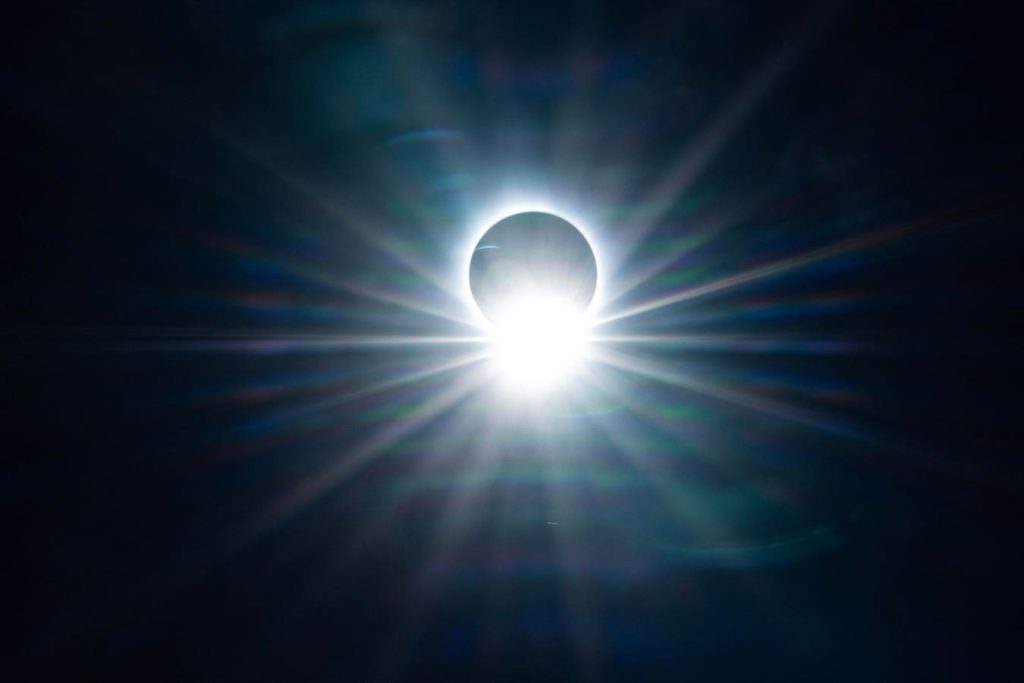Very few witnessed yesterday’s “ring of fire” eclipse in the Southern Hemisphere. But did you really experience totality on Apr. 8, 2024? Some events touted by ill-advised organizers as perfect for witnessing North America’s total solar eclipse were just outside the path of totality. As a result, thousands likely saw a 99.99% partial solar eclipse, with no dark sky and no view of the sun’s magnificent corona. Most would not have known what they were missing.
For experienced eclipse chasers, however, there is a bigger problem: the official maps for the path of totality during all total solar eclipses need to be corrected. Not by much, but there’s enough inaccuracy for eclipse calculators to notice that something is going awry. The causes? The sun’s radius and the topography of the moon and Earth, none of which are being consistently taken into account — until now.
Path Of Totality
Here’s why it’s essential. Whenever there’s a total solar eclipse coming, eclipse-chasers must get into the path of totality — a projection of the moon’s central shadow, the umbra — onto the surface of Earth. Only from inside that path is the sun entirely obscured by the moon’s shadow for a few minutes. The difference between seeing a total solar eclipse and a partial eclipse is, quite literally, like night and day.
Unspoken Truth
Eclipse chasers have known for decades that eclipse maps are wrong. The traditional method of calculating eclipses, invented 200 years ago, assumes that all observers are at sea level on Earth, that the moon is a smooth sphere and that the size of the sun remains constant. In practice, none of that is true.
- The topography of Earth drastically changes where the moon’s shadow falls, changing where the edge of the path of totality is.
- According to NASA, the mountains and valleys along the edge of the moon’s disk affect the timing and duration of totality by several seconds.
- The sun’s radius appears to wax and wane over unknown timescales enough for a projected moon shadow to vary in width.
Calculations also uses something called Delta-T — the rotational speed of the Earth — which in recent years has had to be constantly updated.
None of this is widely publicized when a central total solar eclipse is about to strike. After all, the public finds these events confusing enough without adding more doubt. But for some eclipse cartographers, mathematicians and solar scientists, getting the maps more accurate is an obsession.
‘Grazing Zones’
The truth is that eclipse maps are mostly highly accurate. The only exception — and where any of the above uncertainty causes a problem — is the edges of the path of totality. There may be a definitive line on a map marking the edge of an eclipse path, but in reality, there’s only a “grazing zone” where no one is entirely sure what will be seen or experienced.
Elevation tables on Earth and plots of the lunar limb have been used by eclipse cartographers for years, with eclipse calculations gaining greater accuracy in recent years thanks to new lunar topography data from NASA’s Lunar Reconnaissance Orbiter, which orbits the moon and takes measurements.
The maps available for eclipses use different values for the sun’s radius, so a location that appears to be just within the path of totality on some maps seems just outside on others.
The Solar Radius And Earth
The standard value of the sun’s radius is 959.63 arc seconds (an arc second being one 3,600th of a degree), figures used since the late 1800s, but the sun appears to be larger, around 960 arc seconds. After eclipse modeler John Irwin revealed that the edges of the path of totalty on Apr. 8’s eclipse map would be up to 2,000ft. (600 meters) too narrow and too wide in places, Luca Quaglia — an eclipse calculator based in Australia who has been helping determine the solar radius since 2013 — and his Besselian Team took measurements of what was actually seen at the edge from Stephenville, Texas, where some predicted the eclipse to last 60 seconds, but by Irwin to last 15 seconds. The latter was the case in practice.
The analysis compares umbral shadow path predictions with experimental data, revealing that Irwin’s maps are the most accurate. “We do really need to account for both the moon’s and Earth’s topography and use an improved eclipse solar radius to closely model reality,” said Luca Quaglia in an email.
Meanwhile, NASA has been working on the moon.
The Moon’s Ever-Changing Shadow
At a total solar eclipse, the moon’s exact shape is everything. The valleys on the moon’s edge create two of the most spectacular sights during a total solar eclipse — Baily’s beads and the diamond ring, the last bits of the sun visible just before and the first just after totality. Eclipse cartographer Michael Zeiler at GreatAmericanEclipse.com — one of the first to develop eclipse maps that encompass the “grazing zone” — even computed precisely a map showing where “double diamond rings” would be visible on Apr. 8.
The True Moon
Now, NASA has developed the first visualizations depicting the actual, time-varying shape of the moon’s shadow, with the effects of both an accurate lunar limb and the Earth’s terrain. “Beginning with the 2017 total solar eclipse, we’ve been publishing maps and movies of eclipses that show the true shape of the moon’s central shadow — the umbra,” said Ernie Wright, NASA visualizer at NASA’s Goddard Space Flight Center in Greenbelt, Maryland. “People ask, why does it look like a potato instead of a smooth oval? The short answer is that the moon isn’t a perfectly smooth sphere.”
In a new paper published earlier this month in The Astronomical Journal, Wright sets out exactly how the moon’s terrain creates the shape of its umbra. He uses LRO’s elevation maps of the moon to create a continuously varying lunar limb profile as the moon’s shadow passes over the Earth. However, he also used several NASA data sets to provide an elevation map of Earth so locations were depicted at their actual altitude. The new computer-driven technique can render eclipse maps one pixel at a time.
Pinhole Projections
Perhaps the most visceral highlight of Wright’s work is that he reveals that the valleys on the moon’s edge act like pinholes projecting images of the sun onto the Earth’s surface. The edges of the umbra are shown to be not a straight line nor a “grazing zone” but a series of small arcs from the edges of the projected sun images.
It’s another fine example of how modern science, using complex mathematics and 3D animation software, can reveal something new and wonderful about the natural world.
The next total solar eclipse will occur on Aug. 12, 2026, from eastern Greenland, western Iceland and northern Spain.
Wishing you clear skies and wide eyes.
Read the full article here









